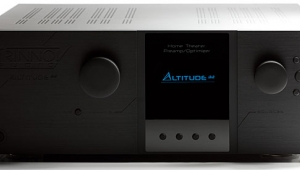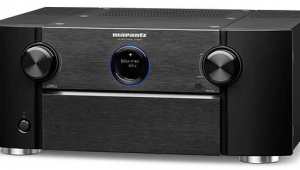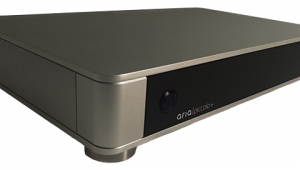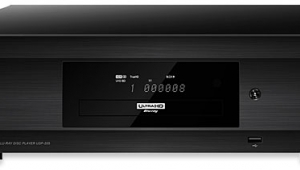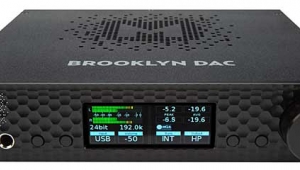| Columns Retired Columns & Blogs |
Music in the Round #11 Page 2
I found much the same difference with Walter Susskind and the St. Louis Symphony's SACD of Holst's The Planets (Mobile Fidelity USACD 4005). This remarkably detailed yet spacious recording sounded great through both players, but the McCormack put the emphasis on power at the expense of some detail. The Orbiter was just a bit less forward, but the instruments were even clearer, as were their placements. In the final diminuendo of the Neptune section, both players trailed off into noise at about the same time—but with the Orbiter, the transition from wordless chorus to indistinct signal occurred later. So, too, with Seiji Ozawa and the Saito Kinen Orchestra's SACD of Bruckner's Symphony 7 (Philips 470 657-2)—I heard a more imposing presentation from the McCormack, but more bow-on-string detail from the Orbiter, especially in the double basses, which power the first movement.
Junior Wells' "Give Me One Reason," on Telarc's SACD Sampler I (SACD-60006), was head-snappingly tight and powerful through the Orbiter, but seemed to have a bit more weight and impact through the UDP-1. The Orbiter seemed to get the balance of Bucky Pizzarelli's Swing Live just right (DVD-Audio, Chesky CHDVD222), while the McCormack was a little larger than life, at least as I recall the recording sessions.
And on and on it went, concluding with Peter Gabriel's new DVD, Play: The Videos (Warner Vision 970396). There was no doubt that the two players rendered the DTS and Dolby Digital tracks superbly, with excellent tonal balance, all niceties in all channels revealed. The McCormack took the flag for immersiveness, but the Simaudio was better at distinguishing the surround elements and at separating the rear left, right, and center.
Overall, the Simaudio Moon Orbiter was a touch more subtle and detailed than the McCormack Audio UDP-1. The Orbiter's audio superiority was more notable when I compared it with the Denon DV-5900, although here the video comparison was a toss-up. If your top priority is sound but you appreciate good video, you should find the Orbiter, at $7200, um, reasonable.
Much ado about something
Many audiophiles carry on about how big a difference a cable can make when, in fact, only quirky or defective designs can have more than a relatively tiny effect on what we hear. That doesn't stop me from saying that I recently changed all the cables and the AC supply in the multichannel system in our country home, and it sounds great. What I now hear is a lower level of background noise and hum, and high frequencies that have been subtly smoothed while retaining their extension. The result of these improvements is increased dynamic range.
But the noise level in my country system wasn't too bad in the first place, even if, when I put my ear to the tweeter of one of my Paradigm Studio/60s, the residual hiss had a distinct edge—almost a buzz—compared to the soft hiss from the Revel Studio tweeters in my two-channel city system. At the low end, I could hear a very low hum from every speaker, but again, only if I put my ear to the drivers, and especially if I turned on the old halogen torchiere. While the hum and hiss weren't consciously perceptible from my listening position, I assumed that they surrounded me when I listened to music. It bothered me.
Being a neurotic audiophile, I had my skeptical electrician run JPS Power AC In-Wall cables from the breaker to dedicated sets of WBT outlets. This change alone eliminated the low-level hum in the main speakers, but the low-level hiss, while reduced, retained its buzziness. I couldn't hear the hiss when my ear was more than 3–4" from the tweeters, but as the room's acoustics improved (see "Music in the Round," January 2005), I became pickier and pickier. I considered two ways of attacking this small problem. I recalled an Adcom power amp that had simply shut down, a Theta amp that had squealed without heroic grounding efforts, and a Bel Canto amp whose power transformer buzzed in sympathy with the evil halogen lamp. I also grew uncomfortable with the need to put an RC network on the Goertz speaker cables I used with these amps, and wondered if the performance of other amps was subliminally affected.
All I wanted was a wire—a high-quality speaker cable without batteries or filter networks that would provide, with a minimum of voodoo, a low-impedance conduit from amps to speakers. What I ended up with were cables from Kubala-Sosna. Their brochure and website are full of the sort of audio platitudes one hears from all the cable companies, but their technical claims were pretty simple. They offer some interesting graphs that purport to demonstrate that their OptimiZ technology results in a lower characteristic impedance and a higher ratio of capacitance to inductance than any other cable (they don't name their competitors).
Joe Kubala sent me three lengths of their middle-of-the-line cable, the Fascination ($800/meter, $250 each additional meter) for the front three channels, and two much longer lengths of the Anticipation ($350/meter, $125 each additional meter) for the rear channels. Not exactly chump change. Each cable consists of a hefty pair of conductors twisted around each other, sheathed with a knitted cover, and, at my request, solidly terminated in thick spade lugs.
Did they make a difference? Probably. There have been no stability problems with any amps so far, the residual hiss is now less of a buzz, and the dreaded halogen lamp could not provoke the Bel Canto eVo6 into the slightest buzz. I have the impression that, with my resident Bryston 9B-ST power amplifier, the highs are now softer but more precise with the Kubala-Sosnas in place. I can't say that the change is substantial, but it is definable, and that, for me, is greatly satisfying. These cables are in my multichannel system for the long haul; Kubala-Sosna's equally attractive interconnects and power cables are next to try out. After that, I don't want to have to think about cables for a long time.
Next time in the Round
My paranoia about AC noise runs rampant next time, as I try out a slew of AC surge protectors, some of which offer such additional features as noise filtering and balanced power. I'll discuss if they do what they're claimed to do, or if they just get in the way. I'll also report on a complete Bel Canto multichannel system—universal player, preamp, and power amps—and, of course, lots of new recordings. See you around.
- Log in or register to post comments


